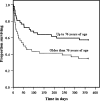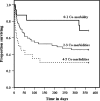Very low survival rates after non-traumatic lower limb amputation in a consecutive series: what to do?
- PMID: 22298857
- PMCID: PMC3329303
- DOI: 10.1093/icvts/ivr075
Very low survival rates after non-traumatic lower limb amputation in a consecutive series: what to do?
Abstract
The aim of this retrospective study was to evaluate factors potentially influencing short- and long-term mortality in patients who had a non-traumatic lower limb amputation in a university hospital. A consecutive series of 93 amputations (16% toe/foot, 33% trans-tibial, 9% through knee and 42% trans-femoral) were studied. Their mean age was 75.8 years; 21 (23%) were admitted from a nursing home and 87 (92%) were amputated due to a vascular disease and/or diabetes. Thirty days and 1-year mortality were 30 and 54%, respectively. Cox regression analysis demonstrated that the 30-day mortality was associated with older age (P = 0.01), and the number of co-morbidities (P = 0.04), when adjusted for gender, previous amputations, cause of and amputation level, and residential status. Thus, a patient with 4 or 5 co-morbidities (n = 20) was seven times more likely to die within 30 days, compared with a patient with 1 co-morbidity (n = 16). Further, the risk of not surviving increased with 7% per each additional year the patient got older. Of concern, almost one-third of patients died within 1 month. This may be unavoidable, but a multidisciplinary, optimized, multimodal pre- and postoperative programme should be instituted, trying to improve the outcome.
Figures
Comment in
-
An enhanced treatment program with markedly reduced mortality after a transtibial or higher non-traumatic lower extremity amputation.Acta Orthop. 2016 Jun;87(3):306-11. doi: 10.3109/17453674.2016.1167524. Epub 2016 Apr 18. Acta Orthop. 2016. PMID: 27088484 Free PMC article.
References
-
- Aulivola B, Hile CN, Hamdan AD, Sheahan MG, Veraldi JR, Skillman JJ, et al. Major lower extremity amputation: outcome of a modern series. Arch Surg. 2004;139:395–9. - PubMed
-
- Basu NN, Fassiadis N, McIrvine A. Mobility one year after unilateral lower limb amputation: a modern, UK institutional report. Interact CardioVasc Thorac Surg. 2008;7:1024–6. - PubMed
-
- Feinglass J, Pearce WH, Martin GJ, Gibbs J, Cowper D, Sorensen M, et al. Postoperative and late survival outcomes after major amputation: findings from the Department of Veterans Affairs National Surgical Quality Improvement Program. Surgery. 2001;130:21–9. - PubMed
-
- Johannesson A, Larsson GU, Oberg T. From major amputation to prosthetic outcome: a prospective study of 190 patients in a defined population. Prosthet Orthot Int. 2004;28:9–21. - PubMed
-
- Lim TS, Finlayson A, Thorpe JM, Sieunarine K, Mwipatayi BP, Brady A, et al. Outcomes of a contemporary amputation series. ANZ J Surg. 2006;76:300–5. - PubMed
MeSH terms
LinkOut - more resources
Full Text Sources
Medical



